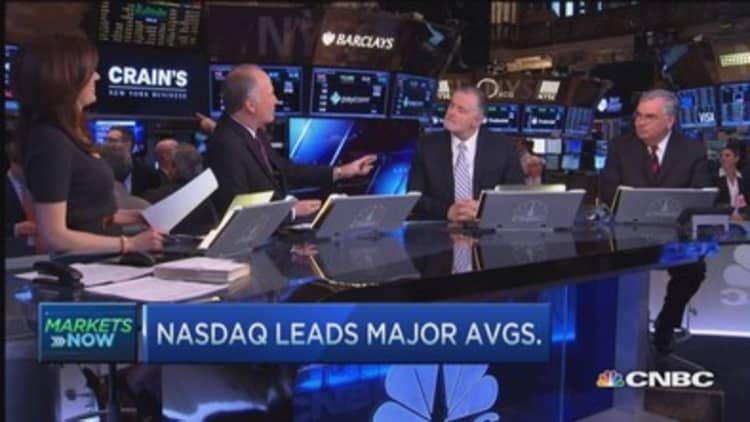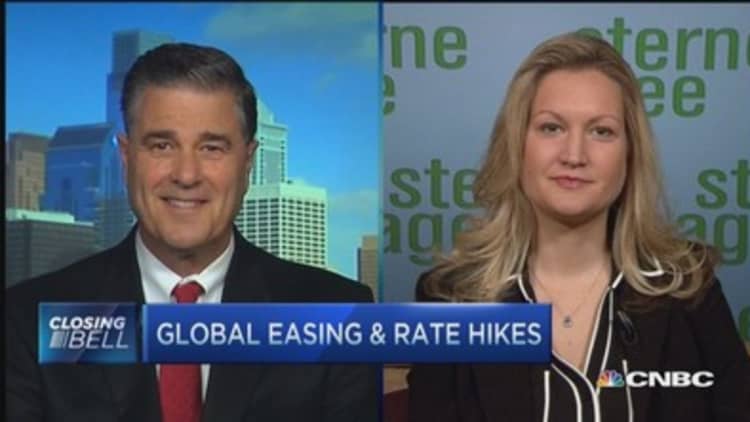


Investors will keep a close eye on weekly jobless claims on Thursday for indications that the economic growth trend is still positive and support a Federal Reserve interest rate hike sooner rather than later.
Stocks traded choppily on Wednesday, searching for direction on the release of the Federal Open Market Committee's March meeting minutes that showed .
"The Fed—in reading through the minutes—they're very focused on a sustained and consistent data trend. The one-offs are not going to affect them," said Chris Gaffney, president of EverBank World Markets. "Tomorrow's jobs data will probably hold a bit more importance than usual."
Analysts polled by Reuters expect 285,000 unemployment claims, up from last week's reported figure of 268,000.
In-line or lower-than-expected claims would indicate that March's disappointing employment report was an aberration due to frigid weather and West Coast port issues. Among mostly soft U.S. economic data, the labor market has seen the most resilience.
Those same seasonal effects could be to blame for the other market headwind of poor earnings expectations.
Read MoreWhy I'm bullish on 2015 earnings: Expert
PNC's chief investment strategist, Bill Stone, expects earnings growth across sectors to decline 4.8 percent due to pressure from cheap oil on the energy sector and the strong dollar on multinationals.
"However, we believe that the bar has been set too low and expect we could see some upside surprise, particularly from energy," Stone said in a note Wednesday. "We expect the benefits of low gasoline prices on the consumer to outweigh the negative impact overall, but we are not yet seeing that in earnings."
Oil plunged on Wednesday, with crude settling down 6.6 percent at $50.42 a barrel, following the highest weekly buildup of inventories in nearly 14 years.
The sharp decline in oil came after two days of rapid gains in the commodity. The Dow transports cheered low oil and airlines helped the index close up 0.71 percent.
Energy stocks weighed on the major averages, with Chevron and Exxon Mobil the greatest blue chip decliners. The Dow Jones industrial average closed up 27.09 points, or 0.15 percent, at 17,902.51. The S&P 500 closed up 5.57 points, or 0.27 percent, at 2,081.90.
The Nasdaq outperformed the other major indices, closing up 40.59 points, or 0.83 percent, at 4,950.82. The iShares Nasdaq Biotechnology ETF closed up nearly 3 percent.
The U.S. dollar turned higher on the initial hawkish read of the Fed minutes and continued to hold gains, while the euro fell below $1.08.
Short-term bond yields jumped on the minutes while the 10-year Treasury note yield held steady near 1.90 percent.
In the unofficial start to the earnings season, Alcoa reported earnings per share after the bell that .
"I think Alcoa is no longer the harbinger it once was," said Marc Chaikin, CEO of Chaikin Analytics, "Alcoa is a different animal because they're really remaking their company."
Instead, "I think the people who focused on the Fed minutes have missed out on a big, big opportunity," Chaikin said. The "cheap money (from low interest rates) and the strong dollar have made mergers and acquisitions feasible."
The market has recently seen a pickup in corporate dealmaking. Generic pharmaceutical firm Mylan proposed buying its peer Perrigo on Wednesday in a $29 billion cash-and-stock offer.
Shell announced a $69 billion deal to take over U.K. energy company BG Group before the bell.
Some analysts attributed Wednesday morning gains, which sent the Dow about 100 points higher, to the "halo effect" of the first major energy deal since Chevron bought Texaco for $36 billion in 2000.
"This new news opens the door for the possibility of a wave of mergers and acquisitions within the industry," said Peter Cardillo, chief market economist at Rockwell Global Capital. "I think stocks are responding to that."
Chaikin sees more opportunity for such deals, noting that the head of Walgreens Boots Alliance recently announced the firm was exploring an acquisition in the United States.
Read MoreStock picks: Why analysts see upside in transports
Walgreens reports earnings on Thursday before the bell.
Potential in companies such as Mylan and Walgreens is "what investors should be focusing on," Chaikin said.


